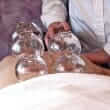Background
- Cupping and moxibustion are healing techniques employed across the diverse traditions of acupuncture and oriental medicine for over 2,000 years.
- In modern times, both methods are usually used to complement acupuncture with needles but they may be used independently.
- Cupping and moxibustion share the principle of using heat to stimulate circulation and break up congestion or stagnation of blood and chi.
- Cupping has some relation to the massage technique tuina, which uses rapid skin pinching at points on the back to break up congestion and stimulate circulation.
- Moxibustion is more closely related to acupuncture as it is applied to specific acupuncture points, while cupping may be used over acupuncture points or elsewhere.
- The literature on these techniques consists predominantly of opinion based on clinical experience, case reports, and a few case series reports in which the methods of observation and analysis are not clear or consistent. This does not mean the techniques do not work, but little of what has been reported can be evaluated as scientific evidence.
References
- Li Y, Liang FR, Yu SG, et al. Efficacy of acupuncture and moxibustion in treating Bell's palsy: a multicenter randomized controlled trial in China. Chin Med J (Engl ) 2004;117(10):1502-1506.
View Abstract - Chen K, Jiang Y, Wen H. [Clinical study on treatment of nasopharyngeal carcinoma by radio- and chemotherapy with supplementary moxibustion on Shenque point]. Zhongguo Zhong Xi Yi Jie He Za Zhi 2000;20(10):733-735.
View Abstract - Wang G, Qu F. Treatment of 482 cases of cervical spondylopathy by combining point-injection and needle-warming via moxibustion. J Tradit Chin Med 2001;21(1):31-33.
View Abstract - Yang C, Yan H. Observation of the efficacy of acupuncture and moxibustion in 62 cases of chronic colitis. J Tradit Chin Med 1999;19(2):111-114.
View Abstract - Joos S, Brinkhaus B, Maluche C, et al. Acupuncture and moxibustion in the treatment of active Crohn's disease: a randomized controlled study. Digestion 2004;69(3):131-139.
View Abstract - Kanakura Y, Niwa K, Kometani K, et al. Effectiveness of acupuncture and moxibustion treatment for lymphedema following intrapelvic lymph node dissection: a preliminary report. Am J Chin Med 2002;30(1):37-43.
View Abstract - Wang GM. [Treatment for 87 cases of peripheral facial paralysis with the integration of TCM and Western medicine and the use of herbs and acupuncture & moxibustion]. Shanghai Kou Qiang Yi Xue 2003;12(4):304-306.
View Abstract - Cardini F, Lombardo P, Regalia AL, et al. A randomised controlled trial of moxibustion for breech presentation. BJOG 2005;112(6):743-747.
View Abstract - Neri I, Airola G, Contu G, et al. Acupuncture plus moxibustion to resolve breech presentation: a randomized controlled study. J Matern Fetal Neonatal Med 2004;15(4):247-252.
View Abstract - Moon SK, Whang YK, Park SU, et al. Antispastic effect of electroacupuncture and moxibustion in stroke patients. Am J Chin Med 2003;31(3):467-474.
View Abstract - Lin X, Wu J, Du J. [Study on effect of spine surgery on gastric function and its efficacy of relevant treatments]. Zhongguo Zhong Xi Yi Jie He Za Zhi 2000;20(11):834-836.
View Abstract - Long X, Chang Q, Shou Q. Clinical observation on 46 cases of infantile repeated respiratory tract infection treated by mild-moxibustion over acupoints on back. J Tradit Chin Med 2001;21(1):23-26.
View Abstract - Zhou W. Acute lymphangitis treated by moxibustion with garlic in 118 cases. J Tradit Chin Med 2003;23(3):198.
View Abstract - Wu C, Wang Z, Ye X, et al. Fifty cases of gastroptosis treated by moxibustion therapy. J Tradit Chin Med 2000;20(1):42-43.
View Abstract - Vas J, Perea-Milla E, Mendez C. Acupuncture and moxibustion as an adjunctive treatment for osteoarthritis of the knee--a large case series. Acupunct Med 2004;22(1):23-28.
View Abstract







